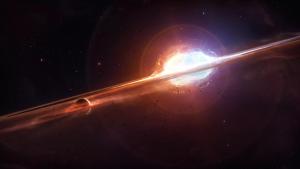Blog
To Hell and Back
2 July 2023
 W. M. Keck Observatory/Adam Makarenko
W. M. Keck Observatory/Adam MakarenkoThe Sun is going to kill us. Not anytime soon, but it will kill us. At the moment the Sun keeps itself going by fusing hydrogen into helium and other heavier elements, but in five or so billion years it is going to run out of hydrogen. When that happens, the Sun will make a desperate attempt to keep going by fusing helium. During this period it will swell to a red giant, likely so large that it engulfs the Earth, baking it to a crisp in its diffuse hot atmosphere.
It’s generally been thought that if the Sun swells beyond the orbit of Earth, the atmospheric drag will cause our little world to spiral into the Sun. The inner solar system simply can’t survive the red giant stage of our star, and so will be consumed in the end. But this might not be the case, as a new study in Nature shows.1
Astronomers in Hawaiʻi have found an odd Jovian planet orbiting a red giant star. The planet, nicknamed Halla, orbits its star at half the distance of the Earth from the Sun. That in and of itself isn’t unusual. Astronomers have found lots of close orbiting jovian planets, known as hot Jupiters. What makes Halla unusual is that its star is in the later stage of its red giant stage.
Using data from the Transiting Exoplanet Survey Satellite (TESS), the team confirmed that the star is steadily burning helium in its core. This means the star is past its largest red giant stage and is in a period of stability before its core finally settles to become a white dwarf. Based on stellar models, during its transition from hydrogen burning to helium burning, the star’s radius would have been 1.5 times that of Halla’s orbit.
In other words, it seems that Halla is a world that was consumed by its star and lived to tell the tale. It’s not clear how this is possible. One idea is that the world originally had a more distant orbit, and during the red giant phase it migrated closer to the star. Another is that as a large gas giant, Halla could survive what smaller Earth-like planets could not.
There are also other possibilities. The red giant star might have originally been a pair of stars, making Halla a Tatooine-like world. The merger of the two stars could have bypassed the large red giant stage, meaning that Halla was never engulfed by the star. Another idea is that Halla is actually a very young planet. A merger of two stars could have created a cloud of gas surrounding the merged star, out of which Halla formed. We don’t have enough observational data to rule out any of these scenarios.
Earth might still be doomed. But this discovery suggests that isn’t a certainty. Life on Earth will be gone long before our planet’s end of days, but it is possible our world can still survive a journey through a stellar hell and back.
Hon, Marc, et al. “A close-in giant planet escapes engulfment by its star.” Nature 618 (2023): 917-920. ↩︎